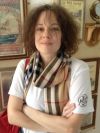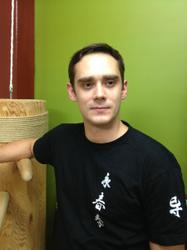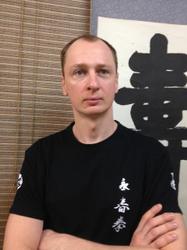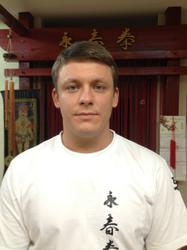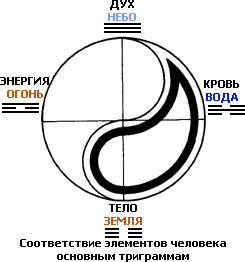Wing Chun Mysteries, Part 1
Yuriy Gritsenko's book is an invaluable source of information for people engaged with Yun Chun Quan, particularly where he talks to the Master Nguyen Hong Tu. The Master answers over a 100 questions about the physical, metaphysical and spiritual aspects of Yun Chun Quan martial arts. The Vietnamese name for the spiritual family school is Tyeu-lam Fat-son’. The first part of the name (Tyeu-lam) means Shaolin Temple. The second part (Fat-son) means mountain Buddhism or spriritual purpose.
When reading extracts from this book (which will be published on our web-site) you will be fascinated by the wisdom of the teacher. We will try to communicate with each other and think independently.
How are theory’ and practice’ combined in martial arts?
|
THEORY/FIRE SCIENCE, METHOD PHILOSOPHY EARTH WOOD
RESULT OF PRACTICE EXPERIENCE METAL WATER The connection between science, theory, method and practice stems from the original natural elements |
Science, philosophy and development all bear a theory. The theory, applied to a particular area of activity, results in a method. Methods are directly realized in practice. Practice spawns results and experience. Collating previous experiences aids specialisation and feeds the science and philosophy. The collection of experiences breaks down the narrowness of the theory. Solely working on theory hinders practice. In essence practice contradicts science and philosophy. A flexible philosophy has an oppressive effect on pure straight-line method. Ancient methods hinder the gaining of new experiences.
From the illustration it can be seen that theory is the opposite to practice. This is why they can only be united by the third element: method. In Wing Chun, the theory’ is always realized in real life thanks only to special methods.
According to the Wing Chun point of view, what is the difference
between a Western and an Eastern person?
Perhaps the Western person is different from the Eastern one in his education, his way of thinking and overall world perception. But, in recent times, a closer inter-connection between East and West erases these differences more and more. From Wing Chun's point of view, these two types of people can be compared in four different ways: spirit, form of movement, strength and speed. In relation to spirit and form, there can't be any difference. Figures show that the average weight of an Eastern person is slightly lower, but that his average speed is higher than that of the Westerner. What is indisputably equal in both peoples’ is that both have a similar chance in achieving Mastership. Everything depends on ones dilligence in the right exercises.
Apart from the internal and external forms, there are also soft’ and hard’ martial arts systems.
What is professed in your school?
| Hard way ZYONG AM (YAN) (YIN)
Soft way AM ZYONG (YIN) (YAN)
Ending: Result of both ways
Perception of the soft’ and the hard’ way and their final results |
Yun Chun Quan generally regards itself as a calmness of spirit, a calmness of breath. The tendency is for a body to be hard’, but sufficient work on it aims to achieve maximum strength with minimum effort. Achieving this is helped by adopting a special (soft) approach to exercising, living and martial combat.
The hard way is very strong but physically quite difficult. Success in it only comes after at least five years of correct exercise.
The soft way is morally’ harder, but easier physically. Success may be achieved after three years’ correct exercising.
No matter how different the soft and strong style of martial arts, their target is the same: to lead to a balance of softness and hardness.
What role does astrology play in your school?
Eastern astrology is directly connected with the Am-Zyong circle, Basic Elements, trigrams and hexagrams.
|
SPIRIT/SKY ENERGY/FIRE BLOOD/WATER BODY/EARTH
Correspondence of human's elements to the main trigrams |
Our school respects the Taoist traditions to the same degree as Buddhist traditions. From the Taoist point of view, it is necessary to consider the location of the planets and the stars. So too must the following be considered: The Moon and the Sun, the Times of the Day, the Seasons of the Year, as well as the annual rhythms. Only in this way can the concordance between the micro- and macro-cosmos be achieved.
From the Buddhist perspective, one has to achieve a state of spirit - a spirit that becomes independent from internal and external factors.
How can this contradiction be resolved?
My teacher used to say: “For as long as one's spirit is weak, he looks at the stars, but when one's spirit becomes strong, all stars look at him.”
An simple astrological system in Yung Chun Quan incorporates the following list of the elements:
Am and Zyong - Moon and Sun
Fire - Mars
Earth - Saturn
Metal - Venice
Water - Mercury
Wood - Jupiter
Seven colours - seven stars of the Great Bear
Eight trigrams - location of the Great Bear
Using the system of Basic Elements and trigrams, the question of when is the ideal time for exercising, treatment or problems solving can be answered.



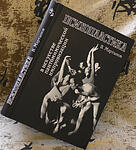

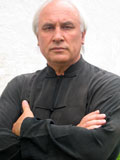 Коан – вопрос к членам Федерации Юн Чун Цюань от президента В.В. Мартынова: «Что Вы сделали для Федерации из того, что не мог бы сделать любой другой за деньги?»
Коан – вопрос к членам Федерации Юн Чун Цюань от президента В.В. Мартынова: «Что Вы сделали для Федерации из того, что не мог бы сделать любой другой за деньги?»